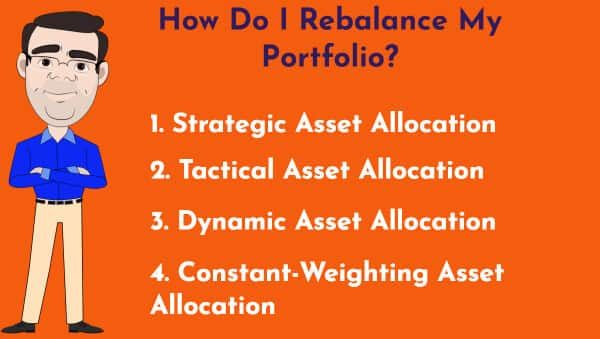You may be surprised that 90% of the returns in any portfolio are contributed to a simple asset allocation & Portfolio rebalancing strategy. Remaining 10% because of timing, portfolio construction & selection of individual investments.
What is Portfolio Rebalancing?
Portfolio rebalancing is the act of comparing the original asset allocation of the investment portfolio to the current asset allocation and then buying or selling investments to ensure that the original asset allocation is maintained. Usually, a threshold is attached to the asset allocation and you should take action if the variation in the asset allocation is beyond the set threshold.

Read Also: Importance of Financial Planning in Your Life
For instance, you set up an asset allocation strategy of 60% equity and 40% debt with a threshold of 5%. You will take action on the portfolio only if the allocation ratio changes more than 5% in either direction.
After a year, you notice that the debt component has increased to 50% and the equity component has reduced to 50%, you may want to set the allocation right. If the debt component has increased to 44% and the equity component has reduced to 56%, you may choose to keep it as-is as the change has not breached the threshold level of 5%.
When Should I Rebalance Portfolio?
As in most cases in personal finance, there is no one correct answer to this question. It depends on various factors –
- Your financial goals have changed which calls for a different asset allocation. If you decide to buy a house, it calls for a change in asset allocation.
- Your risk tolerance level or risk-taking capacity has changed and does not match the asset allocation. You have changed from a regular job to a freelancing role which might mean irregular income and this can necessitate a change in the asset allocation strategy.
- You want to sell off certain investments or invest in a new asset class.
- The performance of the portfolio is not optimum and you and/or your financial advisor think a different asset allocation strategy can bring in better returns.
- It is difficult to time the market i.e., buy at the lowest price and sell at the highest. Rebalancing allows investors to stick to the plan, face downturns, and take advantage of uptrends.
As a thumb rule, rebalance your portfolio once a year under normal circumstances. In the case of black swan events like COVID-19, you may want to relook at your portfolio depending on economic conditions and personal circumstances.
How Do I Rebalance My Portfolio?
There are different types of asset allocation strategies or we can say different ways to optimally balance your investment portfolio –
Must Read-Is Your Portfolio Risky?
-
Strategic Asset Allocation
Design a portfolio of a mix of assets to achieve an optimal balance between expected risk and returns for a long-term investment horizon. Up to a large extent, asset allocation does not change over a period of time.
-
Tactical Asset Allocation
Here the investor keeps a watch on how the various assets are performing and try to have a portfolio such that they can maximize their gains. There is more buying and selling as compared to what happens in the strategic asset allocation.
When the COVID-19 pandemic began, stock markets were volatile but gold was steadily rising in value. At that time, Rajeev came to the conclusion that gold will do well this year and increased his allocation to gold. This is a tactical asset allocation strategy. In this case, the investor has to be more active and aware of the market, economy, etc.
-
Dynamic Asset Allocation
Here the portfolio is developed in a similar manner to how it is developed under strategic asset allocation. The aim is to seek maximum returns with minimal risk in the long term. But the investor is more active and keeps adjusting the portfolio depending on changes in the economic environment.
If the investor feels that the stock market will weaken, he will sell off a portion of his equity assets and invest that money in another asset or hold it as cash. When the stock market sentiment is bullish, he will increase the allocation to equity.
-
Constant-Weighting Asset Allocation
With this approach, you constantly rebalance your portfolio such that it remains true to the originally decided mix. For example, if one asset falls in value, the investor will purchase more of that asset, and if the value of that asset increases, you would sell it. It is different from strategic asset allocation which relies on a buy-and-hold strategy, even as the value of the investments changes in the short and medium-term. (most advisors focus on this)

What are the factors to keep in mind while rebalancing my portfolio?
Though there are no hard-and-fast rules regarding portfolio rebalancing, you should consider these factors –
- If your portfolio has made very high gains or steep losses, check if the portfolio remains around the original asset allocation ratio.
- Do not get influenced by market volatility in the short-term. The whole idea of designing an investment portfolio following an asset investment is to maximize returns for the long run and create wealth.
- Portfolio rebalancing should be done at different life stages. If your children have started going to school, you might have a goal of financing their higher education. This might mean you should increase your allocation to equity-based assets to grow your corpus over the long term. If you will retire in about five years, you should shift to an investment strategy where the equity exposure is less and you have invested more in debt instruments. You may want to keep some cash reserves for medical emergencies that your insurance policy will not cover.
- Be mindful of the exit loads, taxes, fees, commission, etc. that will be incurred while rebalancing the portfolio.
- You can optimize your tax outgo while rebalancing your portfolio. Sell the assets that are at a loss strategically to set off against the income for the year to reduce tax liability.
Keep an eye on your investment portfolio and review it regularly so that you have a well-diversified portfolio that gives adequate returns and you do not get any rude shocks.
1. Tactical rebalancing and dynamic rebalancing looks similar to timing market. Can you explain the difference?
2. 90% gains are because of asset allocation and rebalncing. Any analysis/statical back up to support this?
3. Rebalancing reduces volatality or result in higher returns?
Comments are closed.